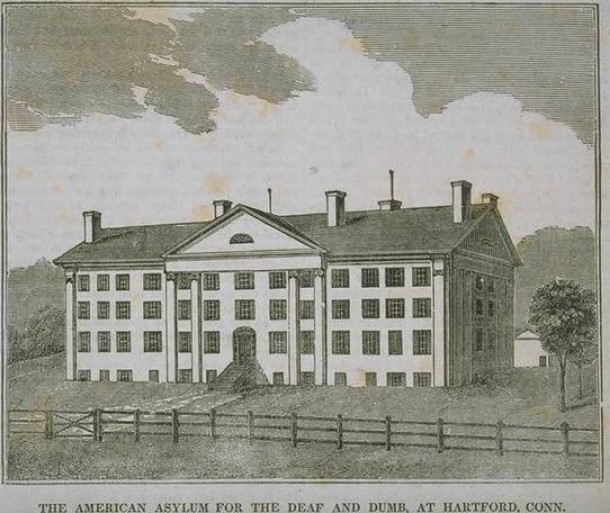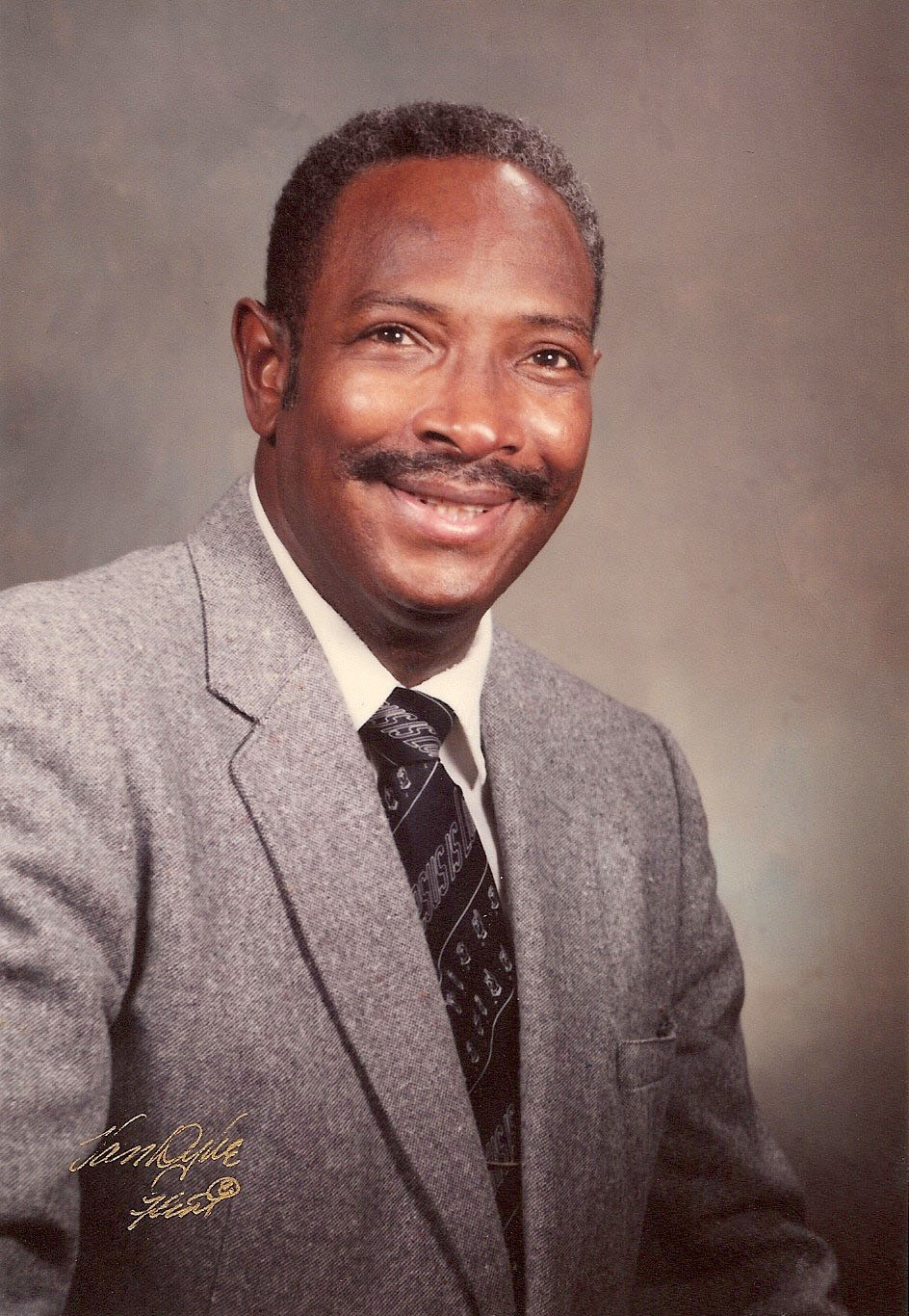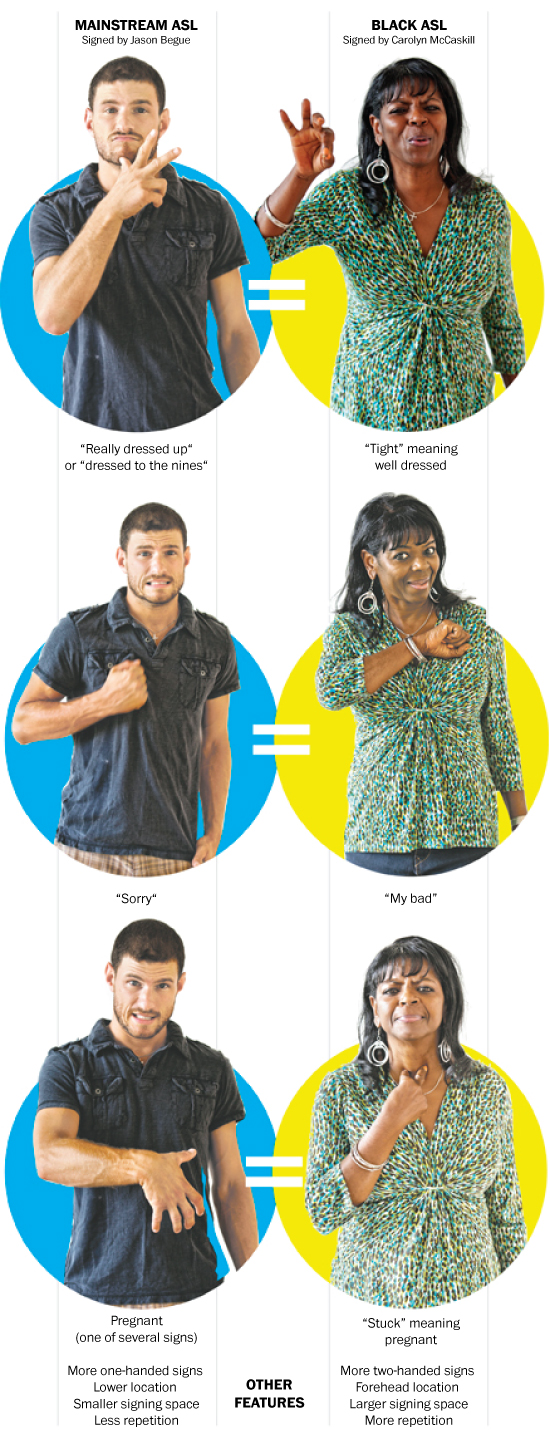The black deaf community is wholly shaped by two marginalized communities: deaf and African-American. For women, the prejudice may reach an intersectionality of three, experiencing sexism, racism, and communication barriers. The history of prejudice and segregation against black folk invented a dialect of American Sign Language (ASL), known simply as Black ASL. The discriminatory practices of the segregation era in the 17th to mid 20th centuries is the root of this fascinating and inherently unique language. Segregation of black deaf schools and white deaf schools diverged into two unrecognizable languages to the other. The professor of linguistics at Gallaudet explains,
Black ASL could be considered the purer of the two forms, closer in some ways to the system that Thomas Hopkins Gallaudet promulgated when he founded the first U.S. school for the deaf — known at the time as the American Asylum for Deaf Mutes — in Hartford, Conn., in 1817.

Black deaf individuals unfortunately were not accepted or supported by the deaf community because of their race or the African-American community because of their disability. During the segregation era, organizations like the National Association for the Advancement of Coloured People (NAACP), the Southern Christian Leadership Conference (SCLC), and the National Urban League were exclusively focused on fighting for equal rights and desegregation of non-disabled African-Americans. The profound issues experienced by the black deaf communities were never a focus of national civil rights organizations, and black deaf individuals had no communication access with these national organizations. An important part for deaf individuals is deaf clubs and organizations. However, black deaf individuals were prohibited from joining these clubs in their communities. A crucial American advocacy organization, the National Association of the Deaf (NAD), prohibited African-American membership until 1965, on year after the Civil Rights Act of 1964. Gallaudet College (now Gallaudet University) was founded in 1864, but hey did not admit black deaf students until 1950. The first black graduate was Andrew J. Foster in 1954, the same year of the Supreme Court case Brown vs. Board of Education decision, which declared segregation of public schools unconstitutional.

Yet, from the 1870s until the 1970s, at least 15, mostly southern states maintained separate schools for black and white deaf students, and integration of students didn’t occur until much after the Supreme Court decision. In 2011, former black deaf students of the Kentucky School for the Deaf received overdue scholarships, denied to them for 60 years. Considering black deaf students were prohibited from social opportunities with white students and teachers, it makes sense that the separation created an entirely new dialect, distinct from White Deaf students’ signs. According to Andrew Solomon, a deaf activist and writer,
The Deaf club is essentially a Deaf person’s second home, providing a place where the Deaf can come together, exchange ideas, develop friendships, participate in social events, and have the opportunity to attain a leadership position within the Deaf community. After World War II Black Deaf [people] found themselves in need of a place to meet so they began to form their own clubs, congregations, and organizations.
The denied acceptance in deaf organizations and clubs for African-Americans created black deaf organizations during the 1950s and 60s in urban cities where segregation concentrated. Many members reside in Atlanta, Baltimore, Chicago, Los Angeles, and Washington D.C. This further shaped the creation of Black ASL. At the NAD convention in Cincinnati in 1980, a group of Black Deaf leaders presented a list of concerns to the convention’s delegates. The list included NAD’s lack of attentiveness to the concerns of black deaf Americans, as well as the lack of representation as convention delegates. Specifically, they requested that NAD take action to communicate better with the black deaf community, encourage involvement of minorities in national and state organizations, and recruit more black deaf children in the Junior NAD and NAD Youth Leadership Camp, all of which entirely hindered black deaf individual’s goal of achieving equality and utilizing national organizations to reach their full potential.
In 1981, a local committee in Washington, D.C. organized the Eastern Regional Black Deaf Conference at Howard University. In 1982, at a national conference in Cleveland called, “Black Deaf Strength through Awareness,” a new organization, the National Black Deaf Advocates (NBDA), was created. The creation of this national organization caused the growth of local chapters in Washington D.C., Cleveland, Philadelphia, New York City, Chicago, Detroit, Memphis, Atlanta, and many other cities. The NBDA currently has 30 local chapters and sponsors various programs such as leadership training programs for high school and college students, a Miss Black Deaf America Pageant, leadership opportunities at the local and national levels, workshops at regional and national conferences, and a scholarship program for black deaf college students.
Even with the improvement of equality for black deaf individuals, the history of racism and segregation has left a lasting impact on modern communication. Carolyn McCaskill is a professor at Gallaudet, highlighted the lasting impact in a 2012 Washington Post article. In 1968, when she was 15 years old, she enrolled with nine other black deaf students to an integrated deaf school in Talledega. As the teacher began to address the entire class, McCaskill along with the transferred students were completely lost. McCaskill explained that the hand movements of her teacher was vaguely like her own sign language she grew up on with her two deaf siblings and at the Alabama School for the Negro Deaf and Blind, only a short while away. It had nothing to do with vocabulary, instead they made hand movements for everyday words that looked foreign to African-American students.
I put my signs aside,
McCaskill explained as she had to learn entirely new signs for words and common nouns like “shoe” and “school.” Previously, she had signed “why” and “don’t know” with two hands, now she only used one. She mimicked the signs of the white students who lowered their hands to their chin for “what for” and “know,” rather than signing at the forehead. She also began mouthing the words as she made the manual sign. When McCaskill went home, she switched back to her old way of communicating.
McCaskill and other experts seem to agree that their is a degree of two distinct signing systems, one for whites and another for black, which continues to coexist, even in common spaces like Gallaudet University, where all students socialize and work together. Nearly ten years ago, McCaskill and three other researchers used grants from the National Science Foundation and the Spencer Foundation to investigate the unique structure and grammar of Black ASL, similarly to how linguists had studied spoken African-American English (AAE or more well known as Ebonics). Their assembly and analysis of data from filmed conversations and interviews with 96 subjects in six states is the first formal attempt to describe Black ASL, resulting in the publication of “The Hidden Treasure of Black ASL.” The researchers found a signing system reflective of the history of segregation and the ongoing influence of spoken Black English. The publication emphasizes that similar to Ebonics, Black ASL is not a slang form of signing. Instead, it can be thought of as the difference between American and British English, which both share many similarities, but have definitive differences regarding individual usage. McCaskill’s co-author, Ceil Lucas, a professor of linguistics at Gallaudet believes Black ASL could be considered the purer form of ASL, as it is closer to the systems introduced by Thomas Hopkins Gallaudet when he founded the American Asylum for Deaf Mutes in 1817. Mercedes Hunter, a hearing African American student describes her signing as a from as self-expression,
We make our signs bigger, with more body language.
The researchers refer to this as Black ASL’s larger “signing space.”
There is no universal language for the deaf. Many people believe sign language is a single language that deaf people anywhere around the world can understand. Others believe that sign language is a direct visual translation of spoken languages, meaning that American signers can freely communicate with British or Australian signers. J. Archer Miller, a Baltimore lawyer who specializes in disability rights and has many deaf clients explains that there are many signing systems, and American Sign Language is based on the French system imported by Gallaudet.
I find it easier to understand a French signer [than a British or Australian one] because of the shared history of the American and French systems.
ASL is about 60% the same as French. As well as culture, time has a heavy influence on sign language. Miller explains that the sign for telephone is commonly made by spreading your thumb and pinkie, while holding them up to your ear and mouth. However, to represent the old-fashioned candlestick phone, the sign used to be made by putting a fist to your ear and the other in front of your mouth. It’s hardly surprising that America’s segregated past led to the development of different signs. Contemporary cultural differences continue to influence the signs of African Americans. Schools for black deaf children, the first of which opened 50 years after the Hartford school was founded, mostly resisted integration until well after the Brown vs. Board of Education 1954 decision, and tended to have very few resources. Students were encouraged to focus on vocational careers like repairing shoes or woking in laundries, rather than pursuing academic careers. Many teachers had poor signing skills.
However, a development in the late 19th century led to consistent education in the black deaf community. The oralism movement, based on a notion that spoken language is superior to sign language, placed emphasis on teaching deaf children to lip-read and speak. Oralism was put into practice in predominantly white schools. Black students were continually taught their purely manual form of communication. In the 1970’s and 80’s, oralism fell out of favour, but white signers continued to mouth words, a key difference outlined by McCaskill when she joined the integrated Alabama School for the Deaf. This distinction still exists today.
The cultural differences that exist in America pose a unique challenge for interpreters, described by Candas Barnes, a professional interpreter based at Gallaudet. He describes it as a,
continual decision making process.
It is the same way an African American figure may shift to Ebonics to emphasize a point or work with an audience. The same must be done with interpreters depending on the audience and what form of ASL will represent the interpreted individual. Miller, the disability rights lawyer, also recognizes this challenge. The slight differences could cause an interpreter to inadvertently change the meaning of a deaf’s person statement. For example, the sign for ‘bad’ can mean ‘really good’ in Black ASL; similarly, ‘word’ can mean ‘that’s the truth.’ Mary Henry Lightfoot, a former board member of the National Alliance of Black Interpreters who works at Gallaudet, says the features associated with Black ASL like facial expressions cause some interpreters to misunderstand.

I’ve heard African American signers say, ‘Don’t make assumptions about what I’m saying based on what I look like.’
In the classroom, like at Gallaudet University, there is limited use of Black ASL. In professional settings, students and teacher generally employ the formal norm. However, as students break into smaller discussions in the classroom, the signing shifts. Students refer to regional differences and discuss using different forms of ASL, like Black ASL. Black studnets at Gallaudet explain,
It shows our personality.
Teraca Florence, a former president of the Black Deaf Student Union at the university, where only 8% of the student body is African American says,
Our signing is louder, more expressive. It’s almost poetic.
However, even with recognition of the uniqueness and history of Black ASL, many worry about how their signing is perceived by their white counterparts. Often the language is perceived as aggressive or seen as a less correct, stereotyped, street language, which echoes how the use of Ebonics is treated in society. McCaskill has felt these concerns before. She remember that to fit in with the white kids at her newly integrated school,
I would pick up their signs.
Yet, when she went home, she remembers,
friends and family would say, ‘Wait a minute, you’re signing like the white students. You think you’re smart. You think you’re better than us.’
Sources-
National Association of the Deaf
Images-
The American Asylum for the Deaf and Dumb
A Note from the Author:
I felt that highlighting the existence of Black ASL is important because for me, understanding the way the languages diverged pointed towards and confirmed where differences come from. It is easy to look a differences as simple as regional languages and mock it, ignore it, and disrespect it. More likely than not, there is a deep history that formed those differences. By acknowledging that history, which for marginalized communities is often rooted in suffering, these differences can finally be respected. I personally believe that the fact that ASL has a norm disrespects the history and importance that Black ASL has towards the black deaf identity. I hope that in the future the worries of the black deaf who use Black ASL can not only be widely recognized by the deaf community, but the fears can begin to be deconstructed trough national organizations for the deaf. The differences between ASL and Black ASL must be understood in order for the poetic and unique expressiveness of Black ASL to be understood and interpreted properly, supporting the identities of the black deaf. For hearing individuals, specifically those who are attempting to learn ASL, I hope these differences are also recognized, and further, when one is beginning to learn the language, they explore both sides of history and find a way to appropriately use both!
